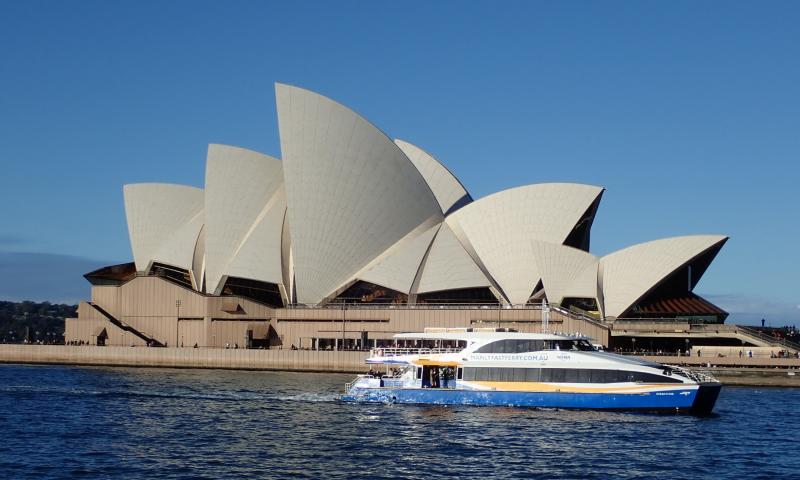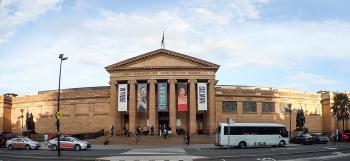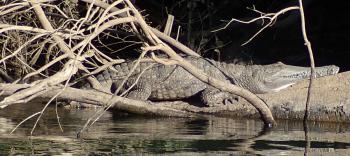Touring Australia’s Top End in winter
This article appears on page 20 of the April 2020 issue.
July is midwinter Down Under — not the best time to visit many parts of Australia but the ideal time to visit the tropical Top End. So when a fare of $665 per person, round trip from Denver to Sydney, popped up for travel in July 2019, my wife, Kathy, and I just had to grab it.
Getting there
Following a Delta flight from Denver to Los Angeles, we caught our connecting Virgin Australia flight to Sydney. We had splurged on the “Economy X” upgrade for $155 per person and were delighted to find that the extra legroom alone was worth it. We always reserve a window seat for Kathy and an aisle seat for myself, and, as often happens, the middle seat remained empty. What luxury!
Economy X had its own section of the cabin, just behind business class, and it included guaranteed meal choices and the loan of top-quality Phitek noise-canceling headphones. The tray table folded in half and could slide in and out, so I was able to use a full-sized laptop comfortably even when the passenger ahead of me reclined his seat fully.
Sydney to Darwin
As usual, we stayed with a dear friend in Sydney, where the weather was unseasonably mild for midwinter. Four days of sunshine and mild temperatures, from the low 40s to just over 70°F, allowed us to comfortably revisit favorite spots like the Queen Victoria Building, the Opera House (where we attended a symphony concert) and Circular Quay, and we took ferries, like the F4 to Watsons Bay, where we made the delightful walk to the Hornby Lighthouse.
To get around Sydney on the very efficient system of buses, trains and ferries, use the tap-on/tap-off Opal card, which can be purchased in many places. Just ask at the nearest train station or any news agent where the Opal logo is displayed.
I’d suggest putting maybe AUD20 ($13) on the card, then watch the balance as you tap on and off. Topping up is easy, with cash or a credit card.
Fares vary according to distance and time of day. Our train journeys from Marrickville into Sydney’s Central Business District, about seven stops, usually came to AUD2.50, less than $2.
After several days, we flew with Qantas nonstop from Sydney to Darwin, heading for daily temperatures of about 66°-90°, considered “cool” by the locals in the tropical Northern Territory.
In Darwin, we called Bargain Car Rentals (www.bargaincarrentals.com.au) from the airport and were picked up and driven a short distance to their rental facility. We rented a front-wheel-drive Kia Rio with automatic transmission for AUD58 per day, including the “additional driver” fee for Kathy, plus AUD25 for the “Gold Liability” insurance package. The total for 13 days came to AUD1,097 (roughly $715).
We had booked four nights at the Adina Apartment Hotel Darwin Waterfront (www.adinahotels.com) in Darwin Harbour’s fairly new Waterfront development. We welcomed the clean, almost swanky accommodation, with cooking facilities and a fridge, paying a total of AUD796. Parking cost AUD15 per day.
The city center, with Coles supermarket and a large visitor center, was a short walk away, and right by the hotel was a very fine restaurant, Snapper Rocks (snapper.rocks), which we visited twice for dinner. There was no snapper on the menu, but there was excellent barramundi and croc meat!
Some high points we enjoyed in Darwin included the George Brown Botanic Gardens (free), with remarkable boab trees, featuring thick, water-retaining trunks, and many other indigenous plants; the Darwin Military Museum (www.darwinmilitarymuseum.com.au; AUD20/AUD15), with excellent displays on the history of the region, especially the Japanese bombing raids of 1942; the Museum and Art Gallery of the Northern Territory (magnt.net.au; entry free), which is really several museums in one, and the Mindil Beach Sunset Market (mindil.com.au), which takes place on Thursdays, not far from central Darwin, where you’ll find a huge number of stalls set up along the beachfront promenade, some with arts and crafts and tourist information but most selling food of every imaginable ethnicity. The market is hugely popular with locals and visitors alike, so parking can be difficult; be prepared to walk, but it’s worth it!
Jabiru in Kakadu
East of Darwin lies the huge Kakadu National Park, roughly half the size of Switzerland. Jabiru is the only nearby town, with the only petrol station, supermarket and post office to be found far and wide.
The nonstop drive from Darwin would take a good three hours, but we first stopped at the town of Palmerston to stock up on a cooler and ice and some items we weren’t sure we’d find in Jabiru. Then we turned off the highway and visited the area of Fogg Dam, where we saw the first of many crocodile warnings.
Walking on the dam (really just a slightly elevated road on a man-made berm separating two areas of wetlands) was prohibited because of the dangers of crocs. We walked along a safe trail into the wetlands, always on the lookout but never seeing a croc, though we did see lots and lots of birds.
Accommodation in Jabiru consists mainly of two “resorts” and a standard hotel, Mercure Kakadu Crocodile Hotel (all.accor.com), of the Accor chain. The resorts can accommodate RVs and camper trailers of all sorts, even tents, and they have a number of rooms for travelers not sleeping in their own conveyances.
We had reserved a “bush bungalow” at the Anbinik Kakadu Resort (anbinik.com.au) for the only two nights it was available. Built on stilts, the bungalow had porous walls, so the breeze could go right through, but strategically placed cloths offered a modicum of privacy.
We loved it but didn’t sleep all that well, even with heavy-duty silicone earplugs, because some birds were noisy all night, and swarms of screeching white-crested cockatoos made alarm clocks redundant from before 6 a.m. onward.
For the subsequent three nights, we stayed in a room in a “sixpack,” a building with six rooms that share a common space, with kitchen facilities. With both types of accommodation, the bathroom and toilet were in a separate hut a few steps away. We had power and hot water, so we weren’t really roughing it, just living a bit rustically.
The Anbinik’s restaurant served exclusively Thai food, and the Pad Thai I ordered was excellent. For a change of fare, we walked across and down the road a bit to the other resort for a more varied menu.
On the first morning in Jabiru, we drove a few minutes to the delightful Bowali Visitor Centre for info about the park. Two very personable ladies did their utmost to provide information, maps and more, and an on-site café invited visitors to linger, study the maps and do some planning, all the while savoring tasty sustenance.
We decided to take a free, ranger-led 2-hour walk near Ubirr, where we learned about Aboriginal culture and history, expressed through the rock art there. On another day, a sunset walk took us to a lovely billabong (Aussie for a pond or small lake) called Anbangbang and up onto the Nourlangie Rock, where we sat waiting for the sun to set while the Aboriginal ranger told us more about the ways of the indigenous people.
Katherine
Heading southwest from Jabiru on the Kakadu Highway, we stopped at a location called Bukbukluk Lookout. With a name like that, how could we not take a luk, ahem, look? There was pretty country as far as we could see and, again, birds galore.
There are supposed to be close to 300 bird species in Kakadu! The best time for birders is late winter, when billabongs have dried out and birds flock to the ones that still carry water.
Passing the town of Pine Creek, where the Kakadu Highway joins the Stuart Highway, we continued an hour south to the town of Katherine, where we stayed at the St. Andrews Serviced Apartments (standrewsapts.com.au) in the center of town. Our flat (AUD275 per night) was impeccable and quite a contrast from the one in Jabiru, with the modern conveniences of a fridge and a full kitchen, AC, laundry, etc. Shops were two blocks away.
The famous Katherine Gorge in nearby Nitmiluk National Park is the area’s main attraction, and we took the 7 a.m. cruise (nitmiluktours.com.au; AUD99) that offered wonderful views as the sun came up and kissed the rock faces, creating stunning reflections on the quiet water.
Our guide explained the geological features, how and where the water comes from and where it goes, the seasonal changes, how the indigenous people cope with the seasons and much more.
Since the water level is low in the dry season (winter), we had to get off the first boat and, after an easy 10-minute walk across a flat bed of rocks, board another boat, switching again on the way back.
We also had a great time at The Katherine Museum (katherinemuseum.com), which showed all manner of details illustrating the history of this former frontier town. What a life the early settlers led!
We then drove to the Edith Falls area, about an hour north of Katherine in Nitmiluk National Park, where an upper waterfall feeds a pool from which another waterfall flows into a lower pool. Both are popular swimming holes… when declared safe by the crocodile patrol.
Heading back
The drive from Katherine back to Darwin takes less than half a day along the excellent Stuart Highway, so we made a detour into Litchfield National Park. We only had time to visit two of the many attractions — Wangi Falls and Florence Falls — both very pretty but not overwhelming at that time of the year, especially after a drier-than-usual wet season.
Back in Darwin, we stayed overnight at the Mercure Darwin Airport Resort, which offered a choice of regular hotel rooms and freestanding bungalows. Our “standard” room ($114) was tiny but adequate for our last night in the Top End.
The next morning we took a flight back to Sydney, where we spent another five days. Among the city highlights was the Art Gallery of New South Wales (artgallery.nsw.gov.au), more museum than gallery, with its splendid permanent collection of Aboriginal art. We also visited the Australian Museum (australianmuseum.net.au), where a generous exhibit on the struggle of the Aboriginal people over the last century caught our attention.
Our main takeaway from this trip was a renewed and deepened awe and appreciation of Aboriginal history and culture. So much ignored, misunderstood and maligned since the early days of colonization, these people and their culture are only now getting some respect. We were glad to learn a lot on this trip.
The details
Prices overall for this trip were very reasonable, even in out-of-the-way places where a premium would be justified. (A main course in Jabiru cost between AUD20 and AUD35.) Petrol was expensive, around AUD1.40 per liter, or roughly $5.40 per US gallon. Out in the open country it can be more, and filling opportunities can be hundreds of kilometers apart.
Hugely refreshing was the culture of no tipping — not in taxis, not in shuttle buses, not in restaurants. At the end of a river cruise, if the guide stands by the gangplank with a hand extended, it is not about money; it is to help the passenger across a wobbly step. Your coins left on the bar will be pushed toward you with the words “You left your change, mate.”
In Sydney, we had purchased SIM cards from Telstra, the telecom company that has the widest reach across the country. We paid AUD30. I can’t remember the gigabyte numbers for data and such, but whatever the capacity was, it served us well for a month to make the occasional local phone call, read emails, etc. We made no international calls and didn’t stream videos, but we used mapping and GPS extensively plus the occasional Google search.
On our last day in Sydney the weather changed, reminding us how unpleasant and chilly the rainy and windy days in winter can be. Oh, well. We were packing…
Editor’s note: Beginning in September 2019, wildfires across the country burned millions of acres of forest and devastated towns. At press time, all fires had been contained, aided by torrential rains in early February 2020 (which led to flash flooding in some areas). As many as one billion animals perished, thousands of homes were lost, and at least 34 people, including a number of firefighters, were killed. The states of New South Wales and Victoria — both in the southeast — were the hardest hit.



